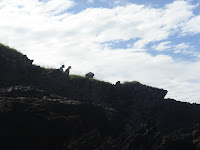 Colin, A Rocha Director, explained that the little island we can see from Mwamba's beach is Whale Island where Rosiate Terns breed between September and December each year. There had been a problem a few years back with rats on the island and it was believed that everything was OK. However rat droppings had been spotted recently, probably from rats that had swum ashore from boats moored nearby. Having rats here would decimate the young terns at the next breeding season and had to be got rid of.
Colin, A Rocha Director, explained that the little island we can see from Mwamba's beach is Whale Island where Rosiate Terns breed between September and December each year. There had been a problem a few years back with rats on the island and it was believed that everything was OK. However rat droppings had been spotted recently, probably from rats that had swum ashore from boats moored nearby. Having rats here would decimate the young terns at the next breeding season and had to be got rid of..JPG) First we drove to Kenya Wildlife Service near Short Beach. A Rocha has a close working relationship with KWS.
First we drove to Kenya Wildlife Service near Short Beach. A Rocha has a close working relationship with KWS..JPG)
Ted improvised some rat traps out of plastic bottles.
.JPG) We walked to Short Beach and took a boat over to Whale Island - in two crossings, as there were too many for the small boat to take us all at once.
We walked to Short Beach and took a boat over to Whale Island - in two crossings, as there were too many for the small boat to take us all at once..JPG) This island has such a delicate eco-system that not even eco-tourists are allowed to visit. We were highly privileged to go as guests of A Rocha.
This island has such a delicate eco-system that not even eco-tourists are allowed to visit. We were highly privileged to go as guests of A Rocha..JPG) We climbed the 10 metre cliff to join the others on top. No Terns were present at this time and no sign of rats either - but traps were laid and they will be inspected another day to see if bait has been taken.
We climbed the 10 metre cliff to join the others on top. No Terns were present at this time and no sign of rats either - but traps were laid and they will be inspected another day to see if bait has been taken..JPG) We walked on boards to disturb the vegetation as little as possible.
We walked on boards to disturb the vegetation as little as possible..JPG) The view over the sea was stunning....
The view over the sea was stunning.....JPG) as was the view down onto the rock pools.
as was the view down onto the rock pools..JPG) Sahid, one of the KWS staff, was very informative about marine life on the island. We saw the Mauritious Shell and heard about the highly venomous Textile Cone Shell. We saw various types of seaweed - brown algae, padina, seagrass and the string-like serigodium.
Sahid, one of the KWS staff, was very informative about marine life on the island. We saw the Mauritious Shell and heard about the highly venomous Textile Cone Shell. We saw various types of seaweed - brown algae, padina, seagrass and the string-like serigodium..JPG) On our way back to the mainland we saw an African Fish Eagle and this rather characterful fishing boat or dhow.
On our way back to the mainland we saw an African Fish Eagle and this rather characterful fishing boat or dhow..JPG)
By paying attention to each of the many different eco-systems in the area, A Rocha and KWS are helping to conserve biodiversity and the delicate balance between need and supply.
If you'd like to know more, have a look at this link: http://en.wikipedia.org/wiki/Watamu_Marine_National_Park

No comments:
Post a Comment